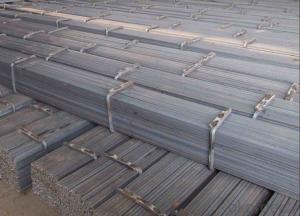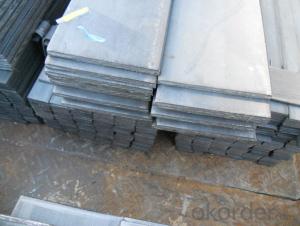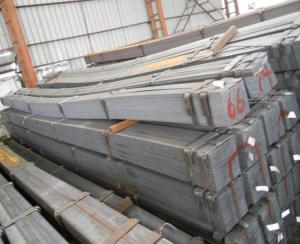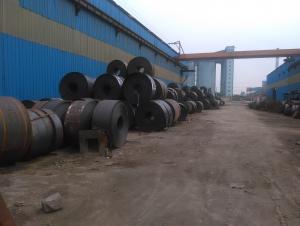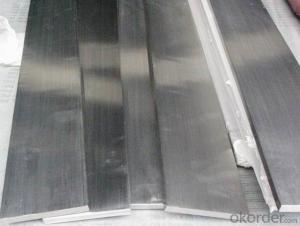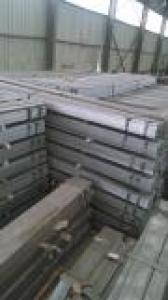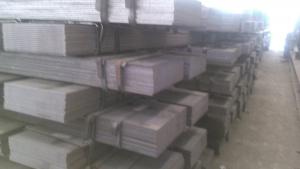High Quality Carbon Steel Flat Bar in Grade Q235
- Loading Port:
- Tianjin
- Payment Terms:
- TT OR LC
- Min Order Qty:
- 25 m.t.
- Supply Capability:
- 100000 m.t./month
OKorder Service Pledge
OKorder Financial Service
You Might Also Like
Specification of Carbon Steel Flat Bar
Commodity: Carbon Steel Flat Bar
Standard: GB,JIS,ASTM,
Material: Q235,SS400 or Equivalent
Brand name: FLATSPACE
Origin place: China
Thickness: 3mm-30mm
Width:20mm-200mm
Length: Max 12m
Certification: SGS/BV
Chemical composition of Q235
Alloy No | Grade | Element(%) | ||||
C
| Mn
| S
| P
| Si
| ||
Q235
|
B
|
0.12—0.20 |
0.3—0.7 |
≤0.045 |
≤0.045
|
≤0.3
|
Physical properties of Q235
Alloy No | Grade | Yielding strength point(Mpa) | Tensile strength (Mpa) | Elongation after fracture(%) | ||||||
Thickness (mm) | Thickness (mm) | |||||||||
≤16 | >16--40 | >40--60 | >60--100 | ≤16 | >16--40 | >40--60 | >60--100 | |||
≥ | ≥ | |||||||||
Q235 |
B |
235 |
225 |
215 |
205 |
375--500 |
26 |
25 |
24 |
23 |
Above sheets show the technical data of Q235,we can also provide other materials similar to Q235.
Usage/Applications of Carbon Steel Flat Bar
Widely used for construction;
Machinery manufacturing;
Iron tower steel structure;
Shipbuilding; Steel grating;
Staircase;
Bridge;
Viaduct;
Railway spare parts;
Boilers making etc.
Packaging & Delivery of Carbon Steel Flat Bar
Packaging Details: The Steel Flat Bars are packed in bundles and loaded in 20 feet/40 feet container, or shipped by bulk cargo ,also we can do as customer's requirements.
Delivery Details:30~45 days upon the receipt of buyer payment by T.T. or L/C.
- Q:What is the use of slitting flat steel?
- Flat cut flat steel, also called fine shearing flat steel strip, can be used to produce iron, tools and mechanical parts, and is used as frame structures and escalators for buildings.
- Q:Are steel flat bars commonly used in the construction of recreational facilities?
- Yes, steel flat bars are commonly used in the construction of recreational facilities. They are often utilized in the construction of structural frameworks, supports, and fixtures due to their strength, durability, and versatility.
- Q:What are the different types of surface finishes for steel flat bars?
- There are several different types of surface finishes that can be applied to steel flat bars to enhance their appearance and functionality. Some common types of surface finishes for steel flat bars include: 1. Hot Rolled: This is the most basic surface finish for steel flat bars. It is achieved through the rolling process and leaves the surface with a rough and scale-like texture. 2. Cold Rolled: This finish is smoother and more refined than hot rolled. It is achieved by passing the steel through a series of rollers under pressure, which results in a smoother and more uniform surface. 3. Pickled and Oiled: This finish involves treating the steel with an acid solution to remove any impurities or oxides, followed by applying a thin layer of oil to protect the surface from rusting. 4. Galvanized: Galvanization is a process in which steel flat bars are coated with a layer of zinc to protect them from corrosion. This finish not only enhances the appearance but also increases the longevity of the steel. 5. Powder Coated: Powder coating is a type of surface finish that involves applying a dry powder to the steel flat bar and then curing it under heat. This results in a durable and vibrant finish that is resistant to chipping, scratching, and fading. 6. Brushed: Brushed finish involves using abrasive materials to create a pattern of fine lines on the surface of the steel flat bar. This finish gives the steel a unique and decorative appearance. 7. Polished: Polished finish involves using abrasive materials to create a smooth and reflective surface on the steel flat bar. This finish enhances the aesthetic appeal of the steel and can range from a satin finish to a mirror-like finish. These are just a few examples of the different types of surface finishes that can be applied to steel flat bars. The choice of finish will depend on the specific requirements and desired appearance of the steel.
- Q:What are the common safety precautions when working with steel flat bars?
- Some common safety precautions when working with steel flat bars include wearing appropriate personal protective equipment such as safety glasses, gloves, and steel-toed boots to protect against potential hazards. It is important to ensure the work area is clear of any obstructions or tripping hazards. Additionally, using proper lifting techniques and equipment is crucial to avoid strain or injury. It is also important to be cautious when operating any tools or machinery, following proper safety guidelines and procedures. Regular inspection and maintenance of equipment and tools should be conducted to ensure they are in good working condition. Lastly, having proper training and knowledge of handling steel flat bars can help prevent accidents and ensure a safe work environment.
- Q:How do steel flat bars perform in high-impact applications?
- Steel flat bars are known for their exceptional strength and durability, making them well-suited for high-impact applications. Due to their flat shape, they provide an effective surface area for distributing impact forces evenly. This helps to minimize localized stress concentrations and prevent deformation or failure under extreme loads. In high-impact applications, such as construction, manufacturing, or automotive industries, steel flat bars excel in absorbing and dissipating energy. Their high tensile strength and toughness allow them to withstand significant forces without breaking or fracturing. This makes them an ideal choice for structural components, support systems, or machinery parts that are exposed to heavy impacts or dynamic loads. The composition of steel, particularly its carbon content and alloying elements, significantly influences its performance in high-impact applications. Higher carbon content can increase the hardness and strength of the steel, while alloying elements like manganese, chromium, or nickel can enhance its toughness and resistance to wear. These characteristics allow steel flat bars to withstand repeated impacts and maintain their structural integrity over time. Moreover, steel flat bars can be heat-treated or tempered to further enhance their performance in high-impact applications. Heat treatment processes, such as quenching and tempering, can improve the hardness, strength, and toughness of the steel, making it even more resistant to impact forces. Overall, steel flat bars are highly reliable and efficient in high-impact applications. Their exceptional strength, durability, and energy-absorbing capabilities make them an excellent choice for various industries where impact resistance is crucial.
- Q:Can steel flat bars be used in the construction of pipelines?
- Yes, steel flat bars can be used in the construction of pipelines. They are commonly utilized for various applications in pipeline construction, such as providing support, reinforcement, and structural integrity. Steel flat bars offer high strength, durability, and resistance to corrosion, making them suitable for withstanding the demands of pipeline environments.
- Q:What are the different storage and handling requirements for steel flat bars?
- Different types of steel and environmental conditions can lead to varying storage and handling requirements for steel flat bars. However, adhering to some common guidelines can guarantee their proper storage and handling. 1. Storage: To prevent corrosion caused by moisture and humidity, steel flat bars should be kept in a dry and well-ventilated area. It is important to avoid direct contact with the ground to prevent potential damage. Stacking the bars on racks or pallets is recommended to maintain their shape and prevent deformation. 2. Handling: Careful handling is necessary to prevent bending, twisting, or scratching of steel flat bars. Employees should use appropriate lifting equipment, such as forklifts or cranes, for moving and transporting the bars. Properly securing the bars during transportation is crucial to avoid accidents or damage. 3. Protection: Shielding steel flat bars from moisture, chemicals, and extreme temperatures is essential. Applying a suitable protective coating, such as oil or paint, can prevent rust and corrosion. Additionally, storing the bars away from materials that could cause damage, such as acids or alkaline substances, is important. 4. Inspection: Regularly inspecting steel flat bars is crucial to identify any signs of corrosion, deformation, or defects. Damaged or compromised bars should be promptly removed from storage and either repaired or replaced, depending on their condition. 5. Documentation: Maintaining proper documentation of the storage and handling of steel flat bars is vital. This includes recording the receipt date, quantity, and relevant details like the supplier or manufacturer. Such documentation serves quality control purposes and can be useful in case of disputes or warranty claims. By adhering to these storage and handling requirements, steel flat bars can be preserved in excellent condition, ensuring their durability and suitability for various applications.
- Q:How do steel flat bars compare to other materials like aluminum or stainless steel?
- Steel flat bars are generally considered to be stronger and more durable than aluminum or stainless steel flat bars. Steel has a higher tensile strength and is able to withstand higher levels of stress and impact. Additionally, steel flat bars offer better resistance to corrosion and are more cost-effective compared to stainless steel. However, aluminum flat bars are lighter and have better corrosion resistance, making them suitable for certain applications where weight is a concern or exposure to corrosive environments is high. Ultimately, the choice between steel, aluminum, or stainless steel flat bars depends on the specific requirements of the project.
- Q:Can steel flat bars be used for making stairs or handrails?
- Steel flat bars are an excellent choice for the construction of stairs and handrails. Being highly durable and strong, they can withstand heavy usage and offer reliable support. With steel flat bars, it is possible to shape and weld them to achieve the desired design and structure for stairs and handrails. Moreover, steel can be coated or painted with different finishes to enhance its visual appeal and protect it against corrosion. In conclusion, due to their strength, versatility, and durability, steel flat bars are widely favored for the creation of stairs and handrails.
- Q:Are steel flat bars available in customized lengths?
- Yes, steel flat bars can be available in customized lengths to meet specific requirements and project needs.
1. Manufacturer Overview |
|
|---|---|
| Location | |
| Year Established | |
| Annual Output Value | |
| Main Markets | |
| Company Certifications | |
2. Manufacturer Certificates |
|
|---|---|
| a) Certification Name | |
| Range | |
| Reference | |
| Validity Period | |
3. Manufacturer Capability |
|
|---|---|
| a)Trade Capacity | |
| Nearest Port | |
| Export Percentage | |
| No.of Employees in Trade Department | |
| Language Spoken: | |
| b)Factory Information | |
| Factory Size: | |
| No. of Production Lines | |
| Contract Manufacturing | |
| Product Price Range | |
Send your message to us
High Quality Carbon Steel Flat Bar in Grade Q235
- Loading Port:
- Tianjin
- Payment Terms:
- TT OR LC
- Min Order Qty:
- 25 m.t.
- Supply Capability:
- 100000 m.t./month
OKorder Service Pledge
OKorder Financial Service
Similar products
New products
Hot products
Related keywords
